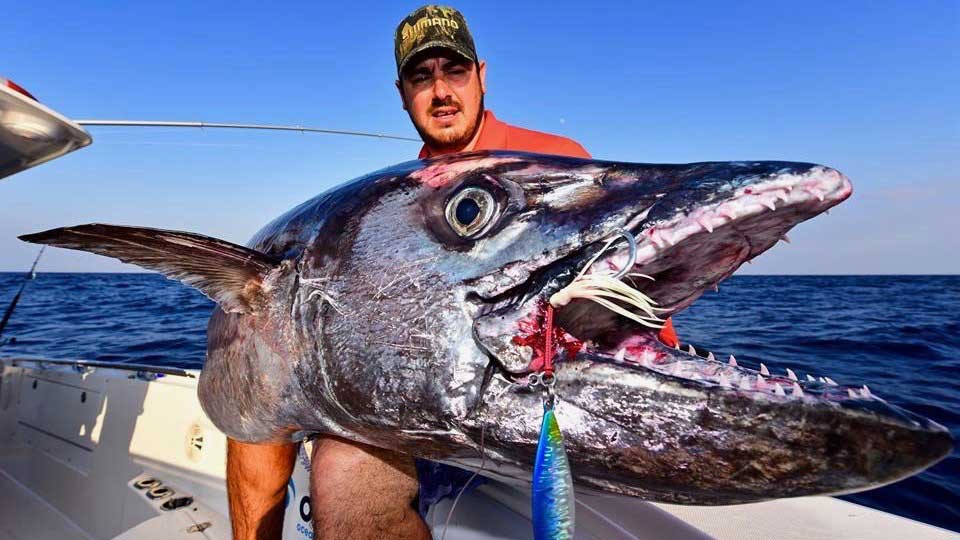Recently we had the pleasure of experiencing one of our clients land a Dogtooth Tuna of 101kg – arguably the Holy Grail when it comes to dogtooth fishing. A 100kg+ dogtooth tuna is sort after around the world and is pretty much hard to come by. But what is a Dogtooth Tuna? Why do anglers target them? In this post, we are going to detail everything we at Ocean Blue have learnt about this goliath of the deep. Here’s how to catch a dogtooth tuna.
What is a Dogtooth Tuna?
Dogtooth tuna (which are sometimes called white tuna or doggies) is perhaps one of the most interesting species of pelagic marine fish – if not the most. However, they neither have anything to do with dogs or tuna. Dogtooth tuna belong to the bonito family and they earned their name because their teeth resembling that of a canine.
Doggies are predatory, with fish and squid as their choice of food. They can grow as large as 248cm (more than 8 feet) and can weigh a whopping 130kg. Its scientific name is Gymnosarda unicolor.
Why Dogtooth Tuna is such a Sort After Sport fish?
We admit, it’s not really the most attractive fish in the ocean. But because of the level of difficulty to catch one, dogtooth tuna are gaining more popularity among anglers all over the world. Here are some reasons why:
You Can’t Find Them Anywhere
Unlike the other “true” tunas such as the yellowfin and Bluefin, dogtooth tuna have a large swim bladder which allows them to adapt to different habitats. They can also frequent certain high current areas, although they can be mostly found in reef edges.
But to catch a dogtooth tuna, you have to look for them in the most specific of places: along the Indian and Western Pacific Ocean, Polynesia, Vanuatu, Japan and north of Australia. But of all these locations, Vanuatu is one of the few places in the world where you can target dogtooth tuna on topwater.
Not an Easy Catch
Catching a doggie is like trying to pass College Honors Abstract Algebra – it is a struggle. And because it is difficult to land, most couldn’t resist having dogtooth on top of their fishing bucket list.
Unlike other species that are very eager to get caught, doggies have refined their bust off technique. Once they snatch your bait or lure they dive down looking for the first bommie to bust you off. Dogtooth tuna are awfully strong so be prepared to hold on tight and hope for the best.”When fishing for dogtooth be prepared to lose a lot more fish than you’ll get to the boat. When you do manage to see a big fish surface the pain is all worthwhile”
– Anthony Pisano
Techniques on How to Catch a Dogtooth Tuna
Though hard to locate and catch, dogtooth tuna can be seized with patience and dedication. Here are some tips and techniques from our Ocean Blue Vanuatu fishing guides.
Be Prepared To Lose More than You Catch
As quoted above, you need to be prepared to lose more fish than what you can catch. Luring and then fighting a doggie is hard work. Be prepared for physical pain as the most popular techniques include jigging or casting. Luring these predators can be strenuous in itself depending on your level of fitness. Then there’s the fight which more often than not will leave you breathless and in tears.
Using bait
Bait is one of the traditional methods in targeting dogtooth. Dogtooth’s favourite quarry are skipjack tuna and rainbow runner. Slow trolling skip baits as well as running baits on down riggers are the most effective methods. The skip bait option also provides anglers with the exhilaration of seeing the fish rise from the depths, taking the bait on the surface.
Using Stick-baits
Stick-baits is the first lure of choice for anglers when fishing for a dogtooth tuna. Larger lures will more likely attract larger fish. In addition, large stick-baits are more effective when retrieved slowly off a location where dogtooth are frequently sighted – like a deep reef edge. Doggies can sometimes be cheeky as they would swim right under the stick-baits but won’t eat – be really patient as eventually they will succumb to temptation.
Using Poppers
The trick is long casts. The longer the lure is in the water the better. When using a popper, make sure to use the stop-and-go method. Dogtooth tuna regularly engulf poppers on the pause. So after a few pops, pause for 3-5 seconds then start retrieving again. Hooking surface caught dogtooth gives you a better chance at landing these elusive beasts. The fish have a lot further to run to bust you off, so if you’re quick and can turn its head while we drive off, all you’ll have to worry about is landing the fish before the sharks do.
Know Where and When to Catch Them
There aren’t a lot of studies made on dogtooth tuna, but according to Vanuatu fishing expert and Ocean Blue head guide Andrea Traverso, dogtooth tuna can commonly be caught from depths as shallow as 1m down to 350m. Traverso also adds that doggies are mostly nocturnal feeders but they can also be active during the day. Though they can be found at specific locations on reef edges to deep underwater sea mounts, we’ve also encountered fish in the shallows chasing stick baits and poppers over reefs. They will also disappear from known haunts from time to time, being true to their elusive nature.
And that’s everything you need to know about and how to catch a dogtooth tuna. If you’re planning to have a shot at a doggie anytime soon, consider our dedicated Extreme GT popping and Dogtooth Adventure.

